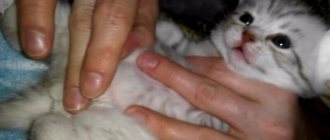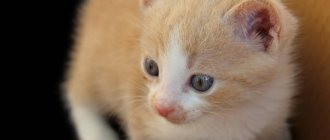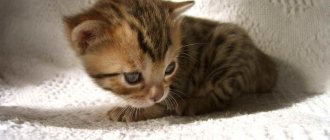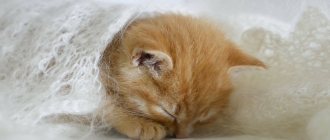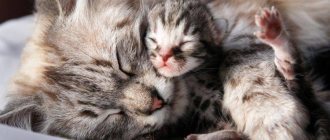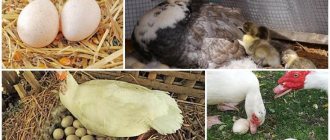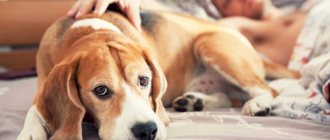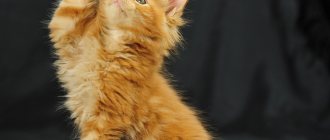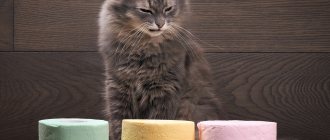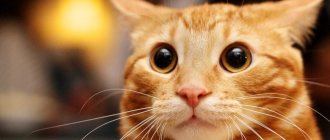Rules for feeding newborn kittens
Teaching a kitten to eat and drink from a bowl is a responsible task for the owner, since a newborn baby, left without a mother and her milk, needs special care and provision of comfortable living conditions.
If such a situation arises, then consultation with a veterinarian is necessary. In this case, newborn kittens are fed from a pipette, and the initial dosage of milk should not exceed more than 2 ml, since they have very small ventricles.
You can teach a kitten to eat from a bowl after three weeks of age, since motor reflexes have formed and he is ready to eat on his own.
Instructions for feeding and introducing complementary foods to newborn kittens:
- after birth, the kitten eats only mother’s milk for the first three weeks (a syringe, pipette with cow’s or goat’s milk is used as a replacement);
- in the period from three weeks to two months, a variety of foods (meat, fish, cereals, legumes) can be introduced into the baby’s diet;
- after four weeks of life, the kitten can be given porridge and pureed vegetables;
- at two months the kitten is ready to eat solid food (bones, cottage cheese, other unground foods);
- after three months, a mature kitten can eat bones, sinews, raw meat, chopped vegetables and fruits;
- After five months, the kitten is ready to eat food that adults eat.
When is complementary feeding introduced and what to feed?
To accustom a cat to normal food, additional food to cat milk should be introduced no earlier than the baby is one month old. Breastfeeding cannot be denied unless there are contraindications for the offspring and the nursing mother. Dry food is suitable - high-quality any brand or specialized for certain breeds, which is eaten by Scots, British, Persians, Siamese or Maine Coons. If the kitten does not eat solid food, you can force it by spreading it a little in the bowl. Then beef is introduced, later replacing it with chicken or turkey, low-fat cottage cheese, low-fat varieties of fish without bones and fins, boiled vegetables (except broccoli, tomatoes, onions and garlic). Small pets should definitely receive chicken yolk and greens. Veterinarians do not recommend mixing portions of regular food with industrial food, as this negatively affects digestion.
How to train a kitten to eat on its own
In order to teach a kitten to eat from a bowl on its own, you need to make an effort, depending on whether the baby is growing up with or without its mother.
A mother cat teaches her child to eat adult food, check its temperature, she shows him how to swallow food, break it up correctly, and with her purring invites him to a meal.
If the baby grows up without a mother, then the owner needs to teach the kitten to eat independently. In this case, the most effective method is considered to be giving a personal example (showing the baby how to lap milk from a saucer).
An effective method is to smear food on your finger or pacifier. The kitten, in turn, will lick it off and gradually understand that this is how it needs to be eaten to satisfy its needs.
Before a kitten learns to lap from a saucer, it is important to accompany each meal with the phrase “let’s go eat,” since the animal will form a clear reflex to this phrase in the future.
At the same time, obtaining the expected result, when the kitten, having heard the phrase, immediately approaches the bowl, takes time (at least 2 months of daily training).
Consequences
A kitten at 4 weeks of age should drink at least 15 ml of liquid per day. Every week this norm increases by 5–10 ml.
Otherwise, dehydration occurs, and the animal experiences the following changes:
- stones form in the animal’s kidneys;
- severe forms of dehydration lead to failure of all body systems;
- the pet’s appearance deteriorates: the fur becomes dull, the mustache and eyelashes become brittle and fall out;
- Due to thickening of the lymph, the water-salt balance is disturbed.
Insufficient fluid intake leads to delayed mental and physical development of the pet.
Why doesn't it work right away?
Many people wonder why it is not immediately possible to teach a kitten to feed from a bowl on its own and should understand that a small kitten that finds itself in a new family takes a longer time to adapt and needs additional care.
In order for the process of accustoming to food to move much faster, you need to diversify your baby’s diet as much as possible. As a result, his taste characteristics will be formed, and he will begin to eagerly eat from the bowl.
During feeding, the presence of the owner is important, since in such conditions the kitten feels comfortable and eats its portion to the end.
How to quickly train a kitten to eat from a bowl
You can teach a kitten to eat from a bowl, if it is artificial, quite quickly using simple techniques:
- a kitten under 2 months of age does not think very well, so in order for him to understand that there is tasty food in the bowl for him, you need to smear his mouth with the mixture or unobtrusively lower his head into the bowl;
- The feeding bowl should not slide on the floor, and a container of water must be placed next to it. It is better to carry out the procedure at the same time, as the animal quickly gets used to the established routine;
- when feeding, do not exceed the servings of food, as in this case the baby’s feeding schedule may be disrupted;
- if the kitten is hungry, then it constantly squeaks, meows and looks for food in a bowl or in various corners of the apartment.
How to change a kitten's diet
A variety of diet is provided gradually after the first three weeks of a kitten’s life, which helps improve the functioning of the digestive system, and the baby begins to enjoy eating food.
List of approved products for small kittens:
- low-fat kefir aged three days;
- smoked meats can be used as a flavoring additive to food to develop a stable reflex to food intake in an animal;
- liquid porridges, vegetable purees;
- boiled meat in small pieces.
If more than 5 months have passed since the birth of the kitten, then it can eat a variety of foods in normal quantities, like an adult animal. Mature individuals have well-developed digestion, teeth have formed, so they are completely ready for adult life.
Classification and features of industrial feeds
On mobile, you can scroll the table horizontally with your finger.
| Name | Advantages | Flaws |
| Economy class Diamond meal Doctor Zoo Vaska Whiskas Darling, etc. | low cost |
|
| Premium class Nutro nuggets Flatazor Pro Pac Happy Cat Royal Canin Doctor Alders, etc. |
|
|
| Super-premium class ProPlan Petreet Hills Nutro Choice Royal Canin Bosh, etc. |
| the cost is quite high |
| Holistics Innova Acana Canidae Eagle Pack Holistic Select Felidae, etc. |
| the cost is high, not affordable for everyone |
Economy or medium class food refers to a type of industrial food that is secretly called fast food for representatives of the cat world. This is the cheapest, most budget option, which has many disadvantages. Such food is made from the cheapest, low-quality products.
There is practically no meat in the composition. The meat part is represented mainly by waste. To enhance the taste of these products, chemical preservatives, flavor enhancers, flavorings, as well as catnip, which is an analogue of valerian, are added to the composition. Giving such food on a regular basis is highly discouraged, as this can lead to serious problems with the digestive system and health of the animal.
Super-premium class - they cost more than economy class, but they do not always meet the requirements. The advantage of such foods is that they do not contain food colors or flavors. They contain more meat than in economy category feeds, and the taste is a level higher. These types of feeds are quite well accepted by the animal’s digestive system.
Holistics are the most expensive class of cat food, but their quality is appropriate. The composition contains a large amount of natural, good meat. No dyes or flavor enhancers. The composition of the food fully corresponds to natural nutrition.
Recommended canned foods
On mobile, you can scroll the table horizontally with your finger.
| Name of food | Advantages | Flaws |
| Bosh Sababelle Super premium class |
| The food contains large quantities of maize and cellulose - components that can provoke a food allergy in a kitten. |
| Pro Plan Junior Premium class |
| The composition contains a high concentration of protein of plant origin. The food contains corn and soy - products that provoke allergic reactions. Preservatives are also present in the composition. |
| Hills Premium class |
| A high concentration of carbohydrates, which are poorly absorbed by the kitten’s digestive system, there are components that can cause allergies, canned food contains a lot of water and broth. |
How to feed a newborn baby
An important aspect is to ensure the correct feeding schedule for newborn kittens who are left without a mother. In such cases, it is necessary to follow simple recommendations:
- It is convenient to feed a kitten with cow's milk from a pipette up to 8 times a day (the temperature of the mixture should not exceed 37 degrees). The temperature is checked by pouring a drop of milk onto the back of the hand;
- if the kitten has reached the age of 1 month, then for feeding you can use a regular bottle with a nipple;
- After each feeding of the newborn, it is recommended to massage the tummy to improve digestion (light strokes clockwise);
- A qualified veterinarian can create an individual diet that will help quickly establish the baby’s digestive process.
Water norm
An adult cat should consume 40 ml of liquid per 1 kg of weight, a kitten needs 10–15 ml per day. This value is not constant, it depends on the weight of the pet.
The daily norm can be easily calculated using the formula: multiply the weight of the animal by a factor of 0.03.
What does it depend on
Cats and kittens eating dry food require more water. Cats that eat liquid food need to drink less.
In summer, with low humidity, the animal will drink a lot and plentifully. This is a normal process of replenishing moisture in the body. In winter, the pet occasionally comes to the drinking bowl.
Important! Cats drink day and night; their drinking bowl must be filled with clean water around the clock. .
Recommendations for training a kitten yourself
Most often, problems with independent feeding in a kitten arise if it is separated from its mother at an early age, since it is she who teaches her offspring to lap from a bowl without problems and in a fairly short time.
If such nuances arise, experts give some recommendations:
- Bowl feeding begins with cow's milk, which is served warm. It is necessary to offer the kitten food and let it smell it. If he is not interested, then you can lightly poke him with his muzzle to fully experience the taste of the product;
- in some cases, the food bowl is not suitable in height, so it is best to purchase it from a special pet store in accordance with the appropriate parameters;
- after the kitten has learned to lap up milk from a bowl, you can gradually switch it to semolina porridge;
- Meat pate for kids is often tried as a new product that can be used during training. At the same time, the reaction to it is ambiguous (some kittens immediately try and eat the product, while others refuse food until they grow up);
- When eating, the kitten must also be given water, since the animal requires mandatory fluid intake, especially after a meal;
- in many cases, small pets love to bathe in a bowl of milk. At the same time, there is no need to limit such actions, since over time, kittens learn to eat well on their own;
- A kitten's normal nutrition can be assessed by the number of trips to the litter box. If they are regular, it means that the pet is well fed, and its digestive system is working stably.
Is there enough water?
The lack of water in the body is determined by the appearance of the kitten. It is enough for the owner to carefully examine the skin and fur of the animal.
- sunken eyes;
- shortness of breath, drowsiness, lethargy;
- the baby rarely goes to the litter box (normally at least 4 urinations per day);
- the fur becomes dull, bald patches appear;
- the skin is dry and flaky.
The condition of the skin is the main indicator of water balance.
To determine the lack of water in the body, the skin on the kitten’s withers is pulled back, just as a cat does when carrying its cubs. If the tubercle straightens quickly, the kitten has enough to drink; if not, it is important to reconsider the animal’s drinking regime.
How to teach a kitten to eat solid food on its own
In some cases, problems may arise when introducing solid food into a kitten’s diet, so you need to follow these simple rules:
- You can try placing small pieces of food directly into the kitten’s mouth. This way he will taste the product and subsequently will not refuse it, but will eat it with pleasure;
- As an initial complementary food, you can use dry food, which is pre-soaked in water. The initial quantity should not exceed 2 pieces;
- When introducing solid foods, you need to pay attention to the baby’s taste preferences (some kittens love cottage cheese, while others are delighted with fish). Based on the information received, a daily diet is compiled;
- It is recommended to start introducing solid foods with liquid porridges (semolina or crushed corn grits are considered the best option);
- dry forms are given to small kittens only after all their teeth have formed.
Kittens begin to eat on their own when they reach the age of 1–1.5 months. Before this time comes, you should try to teach your pet to drink milk and gradually diversify its diet by introducing other products.
Nutrition from 2 months
At this age, the first milk teeth begin to erupt, so it is permissible to introduce solid foods into the diet. However, you should not give up liquid food; it is useful and helps stimulate the normal functioning of the gastrointestinal tract. Solid food is given in small portions, since babies cannot eat much and they spend a long time chewing.
Kids grow, spend more time in active games, so they spend a lot of energy; food should help restore it. Products must be healthy and contain vitamins and minerals.
When the kittens are 3 months old, the owner needs to decide on the subsequent feeding regimen. Several ways are possible:
- Gradual transition to dry food. It is introduced gradually, adding it to the children’s usual diet. Every day the dose of dry product increases. The advantage of such nutrition is that modern food is enriched with all vitamins and minerals.
- Natural food. This is meat, fish, cereals. Additionally, pets are given vitamin complexes.
Keeping and caring for kittens is not an easy task, but it should be approached responsibly. Their subsequent health largely depends on how well they are fed. It is very important to provide the baby who has been abandoned by a cat with a balanced diet. For this you will be rewarded with the boundless love of your tiny pet.
Additional Tips
Kittens at a young age eat small amounts of milk, so a regular plastic lid for cans would be a convenient container for them. It is difficult for a kitten to learn to feed itself in a large bowl, since the milk is distributed unevenly, and the animal simply bathes in it.
Milk for feeding should be at room temperature, as too cold or too hot a formula can adversely affect the health of a small pet. You can heat the product using any available methods (microwave, regular heating), but it is important to check the degree of heating itself (no more than 37 degrees).
At first, a pipette, a syringe, or a container for nasal drops are used as a feeding device for a newborn kitten. The container must be thoroughly washed and sterilized before first use.
A kitten that lives with its mother quickly gets used to eating from a bowl after the cat, since she independently ensures that the offspring acquires all the necessary skills. Therefore, it is better to adopt a small pet after two months of age, when it is completely ready for life in a new home and easily adapts.
Possible problems
In addition to observing the norms and frequency of feedings, it is important to avoid prohibited foods. They can lead to disturbances in the gastrointestinal tract, accompanied by a complete refusal to eat.
An animal left without food for a long time may die.
Refusal to eat
If feeding problems occur in newborns, they must be checked by a veterinarian. Pathological reasons for refusing food at such an early age include:
- hypothermia, that is, low body temperature;
- intrauterine infection with leukemia, chlamydia or other dangerous diseases;
- too low weight associated with pathologies of the placenta;
- any intrauterine development disorders;
- internal injuries;
- hemolysis of newborns, accompanied by the destruction of red blood cells by antibodies supplied with colostrum.
If the baby has always had a good appetite, but increasingly refuses to eat after the introduction of complementary foods, then the problem may lie in:
- Stress
. Separating from the mother too early and abruptly switching to new food is harmful for the animal. - Allergies
. An allergic reaction is accompanied by rashes, hair loss, redness of mucous membranes and other alarming symptoms. To normalize the condition, the allergen is excluded from the diet. - Gastrointestinal disorder
. If vomiting and diarrhea occur, have your pet checked at a veterinary clinic. In addition to the usual eating disorder, worms or other parasites may be found in the body. - Incorrectly selected dishes
. The pungent smell of plastic and the presence of dirt are unacceptable for clean representatives of the cat family.
If any alarming symptoms appear, be sure to contact your veterinarian. Kittens are more vulnerable than adult pets, so any delay can cost them their lives.
Prohibited foods
The list of prohibited foods includes everything that appears on the human table: spices, pickles, smoked foods, fried foods, flour and sweets. You should also exclude:
- pork, often contaminated with worms and causing obesity;
- millet and pearl barley porridge, poorly digestible in the stomach;
- grapes (raisins) and mushrooms that can lead to poisoning;
- garlic and onions, which contribute to the development of anemia;
- sorrel, which causes an acute form of gastritis;
- any bones that injure the esophagus and intestines when swallowed;
- a family of legumes that cause increased gas formation.
Milk is removed from the diet by the age of one year. Closely monitor your pet's reaction to this product. If lactose intolerance develops earlier, then it is not necessary to wait a year. This condition is accompanied by severe bloating and diarrhea, so it is difficult to miss.
